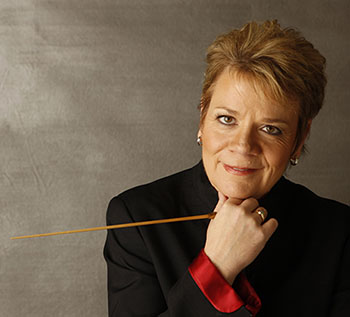French music, Glass and hip-hop Saint-Saëns make for a long afternoon with BSO

Marin Alsop conducted the Baltimore Symphony Orchestra at the Music Center at Strathmore on Sunday.
Marin Alsop’s most recent program with the Baltimore Symphony Orchestra was trying hard to be a lot of things all at once: an updated version of a work usually found on young audience programs, a minimalist showcase, and a mini-survey of French symbolism. On the basis of timing alone, as heard on Sunday afternoon at the Music Center at Strathmore in North Bethesda, it may have been better to cut something.
Written for Shrove Tuesday in 1886, Camille Saint-Saëns’ The Carnival of the Animals is a pre-Lenten masquerade, replete with arch musical jokes. Alsop conducted the orchestral version, in which some of the preciousness of the original chamber version is inevitably lost. Lura Johnson and Michael Sheppard awed and amused on the twin piano solo parts, garnering a few chuckles by adding some “errors” to the scale-exercise drudgery of the “Pianists” movement.
Principal flutist Emily Skala, heard as soloist in last week’s Mozart concerto, flitted agilely in the daring solo in the “Aviary” movement, and principal cellist Dariusz Skoraczewski took a seat between the two pianos for his elegant, ardent rendition of the famous “Swan” solo. The double basses lumbered humorously as the “Elephant,” and the silvery celesta took the part written for glass harmonica in the “Aquarium” movement.
Ogden Nash wrote narration for Carnival nearly sixty years after its debut; then as now–with a new text written and recited by the Baltimore hip-hop artist Wordsmith–having an emcee aboard tends to disrupt the musical flow of the short movements (conceived without interruptions between scenes). While the idea of an improvised rap has a certain appeal, Wordsmith’s text was also printed in the program, albeit with plenty of humorous references to Alsop and a nice poke at critics by way of the “People with Long Ears” movement.
As usual, Alsop was at her best leading a contemporary work — in this instance a rare performance of Philip Glass’s Concerto Fantasy for Two Timpanists and Orchestra. The solo parts were in the capable hands of James Wyman and Jauvon Gilliam, principal timpanists of the BSO and the National Symphony Orchestra, respectively. Placed at the front of the orchestra, they traded star turns in the lengthy cadenza at the start of the third movement, composed by Ian Finkel.
The cadenza is really the only moment when this concerto feels like something more than an orchestral marathon that happens to feature timpani (but with little of the electricity of, say, Carl Nielsen’s Fourth Symphony, “The Inextinguishable”). Glass’s orchestration is regrettably monochromatic, except for the funeral march-like second movement, which grows and recedes in an alluring way.
The relentless orchestral texture was further muddied by the pounding of the timpanists, accomplished though it was, and the volume in the near rows of the floor sometimes made one wish for earplugs — like those worn by the first rows of string players encircling the percussionists.
Finally, the similarity of the first movement’s main motivic idea to Lalo Schifrin’s famous Mission: Impossible theme remains inescapable, and as puzzling as it was when the concerto premiered not long after the first installment of the Tom Cruise cinematic reboot.
Debussy’s La Mer underscored the monotony of orchestral color in the Glass piece, and the BSO’s performance of it sparkled with stormy splashes and prismatic hues. The cello section shone in the section of the first movement for divided cellos, as did the BSO’s outstanding concertmaster, Jonathan Carney in his violin solos. The concluding section of this movement, for brass unexpectedly mixed with harp, was also a highlight.
In the second movement’s “Jeux des vagues,” harp, flute, and piccolo all brought to life the interplay and spray of the waves. Alsop helped give the more Wagnerian writing in the third movement, the “Dialogue of Wind and Sea,” a sinister aura of menace — an unease reminiscent of the dread permeating the composer’s opera Pelléas et Mélisande. Brass and percussion excelled in a memorable big finish.
Ravel’s La valse seemed the prime candidate for excision from this program. A primer on great orchestration, the piece unraveled a bit due to Alsop’s overindulgence in swooning rubato details. Muted dissonances and reeling chromatic scales in the winds created an effective dreamscape in the opening section, with boozy portamenti in the strings. The playing was virtuosic, often devastating, but, at the end of a long concert, a bit exhausting.
Pianist Gabriela Montero joins the BSO for Tchaikovsky’s Piano Concerto No. 1 and her own improvisations, January 19 and 21 in Baltimore and January 20 at Strathmore. bsomusic.org; 410-783-8000.


